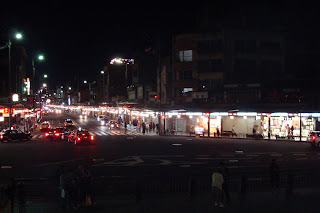Part 2
Part 3
Part 4
Part 5
One of the gifts blogging has given me is a greatly increased appreciation for photography. I used to be indifferent, almost averse to photo ops, reasoning on notability and the power of my own memory, so as a result there are actually some fairly large gaps in my life that I wish I had a little more evidence of. Now, though, I reach for my camera like John Marston reaches for his revolver: At the slightest provocation, with startling speed and accuracy, I will whip it out of my pants and snap off a shot. It's become almost a sub-hobby of blogging itself, and I quite enjoy displaying the occasional pretty picture amid the mass of blurry, incorrectly framed, and poorly lit captures that make up the bulk of my efforts.
With that in mind, I'm going to be something a little more involved than my usual stuffs, and embark on a little Gion Photo Project. In past posts I have simply travelled to a location, seen what I could see, and gone home, but this time I conducted a number of shoots over multiple days, to gather more and varied material. I chose Gion as my subject, just because it's accessible, it's famous, and I think a lot of people might like to see it. Maybe I'm wrong. Hope not.
Gion, of course, is the largest geisha district left in the country. Despite their being a perennial symbol of Japan in the minds of everyone ever, their numbers and significance have dwindled over the last hundred as a result of public apathy, which I would speculate comes from their practicing an outdated medium that nobody enjoys anymore. There is an ongoing push for their preservation, but I'm pretty sure the only way you're going to see a real geisha now is at either a horrendously expensive teahouse or a horrendously expensive performance. That does not mean there's nothing to see in Gion, however.
If you approach Gion from the downtown area, this is the first thing you'll see, sitting directly atop one corner of Gion-Shijou Eki. Notice the mixture of pagoda and Western-style architecture, which suggests the Meiji era, although this might just be me talking out of my hat. Apparently this the place to go for song and dance performances, though obviously I've never been, because I'm not on a business trip or independently wealthy.
Shijou, east from Gion-Shijou Eki. Kinda the main drag of Gion, if you're gonna pick just one. I like it. Not as much as downtown, but it's cool. Gion is often misunderstood to have been the ancient pleasure quarters, which isn't exactly true, but if you got your money, honey, Gion's got your disease, as long as your disease is upscale shopping and dining, which it has in spades. The best restaurants invariably have long lineups piling down the sidewalk and I suspect it's a good place to buy souvenirs.
This is the biggest tourist area in what is already a tourist town, and City Hall knows it. おこしやす、by the way, is just 京都弁 for ようこそ。You know, add a little local flavour to the signage and whatever. Fun fact: The local term for geisha (芸者) is actually geiko (芸子).
Aww yeah, the SKETCHY part of Gion! And right off Shijou, too. Awesome stuff. The density of Girls Bars, kyabakura and dive bars rivals Kiyamachi.
This is just here because I want to stress that Gion is really just a normal part of a normal city. You walk far enough, and you start to find rundown apartment buildings and people living their daily lives. Like everywhere.Though I won't deny that Kyouto has a ton of fun little backroads and alleys to explore. I've spent hours wandering around areas like these.
Is that a magical riverbarge floating above Shijou?! Ah, no, it's the backside of a restaurant on Kawabatamachi.
Go left at Yasaka-san and you'll find the loneliest road in all Gion. I actually started to get introspective and moody just walking down it, pushing past prostitutes and watching the cars fly by.
I walked that loooong path only to find that it kind of goes nowhere.
Planning a trip to Gion? You might want to remember this gate.
Cause this is where it leads. This is probably more like what you envisioned Gion being, isn't it? It's certainly a nice walk.You can maybe find some geiko teahouses if you're seriously looking for one.
Throughout Kyouto at large, you are likely to find Japanese tourists decked out in yukata, but those numbers skyrocket in Gion. Don't immediately assume that you have spotted a troupe of those elusive geiko and start frantically taking hundreds of pictures, as those most eye-rollingest of foreign tourists do. They're there, but you're unlikely to find them. Rule of them: If you see a woman you think is a geiko, she is probably not a geiko. If she's in public and her face isn't painted, then definitely not.
Yasaka-san at night. Two kyabakura girls watched me take this photo. "Now Rude Boy!" you exclaim, positively stamping your feet with indignance. "Just because a girl dresses a certain way in a certain part of town doesn't automatically mean she's a kyabakura girl!" You know what, don't even. Sometimes you can just tell, don't even pretend that you can't. Plus, one of them went into a kyabakura almost immediately after, so yeah, kyabakura girl.
Here's the view from the steps of Yasaka-san, which is going to segue nicely into Part 2.




















No comments:
Post a Comment